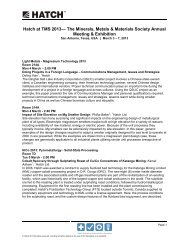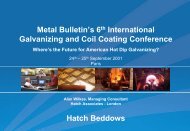Download PDF - Hatch
Download PDF - Hatch
Download PDF - Hatch
Create successful ePaper yourself
Turn your PDF publications into a flip-book with our unique Google optimized e-Paper software.
Premier Issue | July 2011<br />
in this issue<br />
25 %<br />
energy<br />
savings<br />
35 %<br />
fewer<br />
electrodes<br />
$15 million<br />
Saved in budget,<br />
schedule and process<br />
Safety has<br />
a dollar value<br />
Safe workers produce<br />
more, better<br />
Koniambo:<br />
A mine life of 25 years<br />
from 62.5 million tonnes<br />
of saprolite ore<br />
Our band of principles<br />
Nils Voermann<br />
<strong>Hatch</strong> engineer wins PEO<br />
Award for Engineering<br />
Excellence – designing and<br />
installing world’s largest<br />
furnaces since 1999
We have only our employees to thank.<br />
To become a best-managed company, you hire the best people.<br />
It’s that simple.<br />
<strong>Hatch</strong>’s 9,000 people — in 65 offices around the world —<br />
set the standard in delivering value to our clients in the<br />
mining and metals, energy and infrastructure sectors.<br />
We’re project and construction managers.<br />
We’re engineers. We’re business consultants.<br />
And we’re part of <strong>Hatch</strong>’s legacy of excellence.<br />
Learn more about us at www.hatch.ca<br />
Metals • Energy • Infrastructure<br />
AUSTRALIA • BRAZIL • CANADA • CHILE • CHINA • INDIA<br />
PERU • RUSSIA • SOUTH AFRICA • UAE • UK • USA
Premier Issue | July 2011<br />
4 | Welcome<br />
5 | Award-winning project<br />
no surprise to client<br />
Port of Durban expansion, winner of the<br />
South African Institute of<br />
Civil Engineering Award for<br />
technical excellence<br />
6 | Madagascar Minerals:<br />
Patience pays dividends<br />
Rio Tinto's ilmenite project in Madagascar<br />
is one of the world's most honored<br />
resource projects of all time<br />
8 | Xstrata proud of new mine<br />
Nickel Rim mine in the Sudbury basin<br />
shows a modern face in its design of<br />
surface infrastructure<br />
10 | An incredible journey<br />
The design, manufacture<br />
and global transportation of<br />
the world’s largest pressure vessels<br />
14 | QIT’s UGS, the third<br />
and best expansion<br />
International Project of the Year Award<br />
16 | Adelaide Desalination plant<br />
on schedule despite delays<br />
Playing catch-up: $1.83-billion Adelaide<br />
Desalination plant remains on schedule<br />
for completion by December 2012<br />
17 | Impala Platinum,<br />
a milestone project<br />
New furnace achieved “astonishing<br />
performance indices"<br />
18 | Dalrymple Bay<br />
Seventh award-winning coal terminal<br />
expansion makes it world’s largest<br />
20 | AltaGas wind project,<br />
first on BC power grid<br />
Enough wind power<br />
to serve 26,000 homes<br />
21 | Welland Ship Canal<br />
An opportunity to generate electricity<br />
using spill water<br />
22 | Koniambo:<br />
A world-class resource<br />
World-class resource base provides mine<br />
life in excess of 25 years<br />
24 | Mosaic expands mines<br />
Three major mines expanding<br />
to meet growing demand<br />
25 | <strong>Hatch</strong> engineer honored<br />
Nils Voermann wins PEO Medal of<br />
Engineering Excellence<br />
26 | Bruce Power:<br />
Two awards for restarts<br />
Schreyer and Project of the Year<br />
28 | Commendations<br />
Client feedback<br />
29 | Our band of principles<br />
Safety, Quality, Sustainability<br />
and Innovation<br />
29 | Improved safety programs<br />
lead to improved productivity<br />
Economics of safety and quality<br />
30 | Transnet, focus<br />
on infrastructure<br />
The redevelopment and<br />
expansion of ports and railways<br />
Cover photo: Koniambo metallurgical<br />
plant lights up the night<br />
<strong>Hatch</strong> Advantage July 2011 | 3
Welcome<br />
to <strong>Hatch</strong><br />
Advantage<br />
This is a new publication from <strong>Hatch</strong> that<br />
will tell readers how clients receive direct<br />
benefits and added value beyond the<br />
expectations of the project team.<br />
Our clients wanted the<br />
immediate expansion<br />
of reliable and low-cost<br />
production facilities.<br />
For more than 50 years <strong>Hatch</strong> has<br />
established itself as a preeminent<br />
supplier of engineering and construction<br />
management in the Metals, Energy and<br />
Infrastructure sectors.<br />
As the global population grows the demand<br />
for commodities grows and prices rise.<br />
Our clients are committed to the urgent<br />
expansion of reliable and low-cost facilities.<br />
In this new environment of sustainability,<br />
safety management, and high quality, our<br />
legacy of excellence and our experienced<br />
staff have demonstrated that we can deliver<br />
to meet our clients' needs.<br />
This publication shows many examples of<br />
exceptional value delivered on projects.<br />
In one example (p14) client Rio Tinto<br />
completed a 15-percent production boost<br />
three months ahead of schedule and<br />
$15 million under budget.<br />
QIT’s UGS project was the winner in 2008<br />
of the International Project Management<br />
Institute Project of the Year Award.<br />
Kurt Strobele<br />
Chairman and CEO<br />
<strong>Hatch</strong><br />
4
Awardwinning<br />
project<br />
no surprise<br />
to client<br />
The Port of Durban, the largest<br />
in Africa, was deepened and<br />
expanded to accommodate<br />
bigger ocean-going vessels<br />
carrying commodities in and out<br />
of Africa.<br />
BY THE NUMBERS<br />
The project was a component<br />
of the infrastructure program<br />
that won the 2009 Technical<br />
Excellence Award of the<br />
South African Institute of Civil<br />
Engineering.<br />
‘…ahead of schedule,<br />
under budget and<br />
with an excellent<br />
safety record…’<br />
<strong>Hatch</strong> and its joint-venture<br />
partners, Mott MacDonald and<br />
1,000,000+<br />
work-hours without a lost-time injury<br />
19 - m - deep<br />
approach channel<br />
8−11 % immediate<br />
traffic increase<br />
Goba Engineering, provided<br />
all engineering, procurement,<br />
and project and construction<br />
management.<br />
Moira Moses, Group Executive,<br />
Transnet Capital Projects, on<br />
hearing the project won the<br />
award said, “For many years<br />
skeptics were doubtful that<br />
the Durban Harbor Entrance<br />
Channel project would ever get<br />
off the ground.<br />
"Not only did we complete it<br />
ahead of schedule, under budget<br />
and with an excellent safety<br />
record, we scooped one of the<br />
most prestigious awards in<br />
the industry.”<br />
<strong>Hatch</strong> Advantage July 2011 | 5
Madagascar Minerals:<br />
Patience pays dividends<br />
BY THE NUMBERS<br />
85<br />
of workforce sourced<br />
%<br />
and trained locally<br />
3,900<br />
personnel, Madagascar's<br />
largest project ever<br />
12,500,000+<br />
work-hours without a lost-time injury<br />
6
Rio Tinto's<br />
ilmenite project in<br />
Madagascar is one<br />
of the world's most<br />
honored resource<br />
projects of all time.<br />
It was at the time also the largest<br />
project ever undertaken in<br />
Madagascar, an island state that<br />
is home to 200,000 species of<br />
animals of which 150,000 exist<br />
nowhere else on the planet.<br />
<strong>Hatch</strong> was most proud of the fact<br />
that it could recruit and train 85<br />
percent of the workforce from<br />
Madagascar and amass 12.5<br />
million work-hours without a<br />
lost-time injury.<br />
The project established<br />
precedents for very careful and<br />
incremental development, and<br />
still began production<br />
on schedule.<br />
Rio Tinto's approach to the<br />
novel development was one<br />
of sensitivity to Madagascar's<br />
unique ecology, and a singleminded<br />
determination at Rio<br />
Tinto's director level to respect<br />
the company's commitment<br />
to sustainability.<br />
After several years of discussions<br />
with local communities and<br />
national regulators about<br />
how the ilmenite sands could<br />
best serve one of the most<br />
ecologically sensitive regions in<br />
the world, Rio Tinto drew up a<br />
plan to create a dredging mine,<br />
much like Rio Tinto & BHP<br />
Billiton’s successful facility at<br />
Richards Bay, South Africa.<br />
Using a conventional cutter/<br />
suction dredge, a floating<br />
concentrator in the dredging<br />
pond, a land-based minerals<br />
separation plant, and associated<br />
infrastructure (including a new<br />
port facility, a power generator,<br />
a 20-km-access road, and a water<br />
supply), Rio Tinto developed<br />
"a model for future projects<br />
in Africa and elsewhere in the<br />
developing world," said Rio<br />
Tinto's Chief Executive Officer<br />
Tom Albanese.<br />
Despite its remote location<br />
and the need to educate and<br />
mobilize the local workforce,<br />
the construction was completed<br />
in three years and the overall<br />
project in five years.<br />
AN OUTSTANDING PROJECT<br />
• Winner, Rio Tinto's Chief Executive Safety Award<br />
• Winner, The Bentley Innovation in Mining Award<br />
• Winner, The Nedbank Capital Green Mining Award<br />
• Winner, The South African Steel Association<br />
Export Award<br />
<strong>Hatch</strong> Advantage July 2011 | 7
Xstrata proud of new mine<br />
B Y T H E N U M B E R S<br />
15 contracting firms on site<br />
5,000,000+<br />
work-hours without a lost-time injury<br />
25 km of lateral mine shafts<br />
125 km of diamond-drilling<br />
8
Nickel Rim, a new<br />
nickel mine in the<br />
Sudbury basin,<br />
shows a modern<br />
face in its design and<br />
project execution<br />
Xstrata Nickel assigned the full<br />
EPCM scope for engineering,<br />
procurement, and construction<br />
management to <strong>Hatch</strong> in jointventure<br />
with a local partner.<br />
The <strong>Hatch</strong> EPCM team peaked<br />
at 120 members managing five<br />
design groups and up to 15<br />
contracting firms on site at the<br />
same time.<br />
Strict access rules and<br />
performance standards were<br />
imposed on all site personnel,<br />
contractors and suppliers to<br />
guarantee that safety protocols<br />
were obeyed to the letter.<br />
When the project was completed<br />
more than seven million hours<br />
were expended including a run<br />
of five million without a<br />
lost-time injury.<br />
The project’s scope included<br />
all surface and underground<br />
infrastructure, a ventilation shaft<br />
sunk to 1,685 metres, and a<br />
production shaft sunk to<br />
1,750 metres.<br />
The underground infrastructure<br />
includes 25 km of lateral mine<br />
development, and, to prove ore<br />
body geometry, mineral grades<br />
and tonnage some 125 km of<br />
diamond-drilling.<br />
Nickel Rim is now producing at<br />
1.2 million tonnes per annum;<br />
however hoisting infrastructure<br />
is designed to extract up to a<br />
maximum of 1.7 million tpa of<br />
combined ore and waste rock,<br />
when required.<br />
The project was completed<br />
safely, three percent below<br />
budget with first production<br />
ahead of schedule.<br />
Meet the Specialists<br />
Environmental Services Group<br />
Permitting can be a long and tedious step in<br />
the development of a mine, port or power<br />
generation facility.<br />
Protecting the environment, engaging aboriginal<br />
groups and controlling energy costs require special<br />
expertise and knowledge.<br />
Corinne Boone<br />
Global Director<br />
Environmental Services Group<br />
Benchmark: We can show you where you are…and where you should be.<br />
<strong>Hatch</strong> Advantage July 2011 | 9
BY THE NUMBERS<br />
$2.3 billion<br />
capital cost<br />
four 780-tonne<br />
brick-lined <strong>Hatch</strong>-designed autoclaves<br />
transported from Malaysia in Southeast Asia<br />
to the Dominican Republic in the Caribbean<br />
One of four 780-tonne<br />
pressure vessels on the<br />
way to Barricks's new<br />
Pueblo Viejo mine site<br />
10
An incredible journey<br />
The design, manufacture<br />
and global transportation<br />
of the world’s largest autoclaves<br />
Each 780-tonne autoclave<br />
took 18 days to be<br />
transported just over<br />
120 kilometres from<br />
the port at Samana,<br />
Dominican Republic,<br />
to the Pueblo Viejo<br />
operation.<br />
The Pueblo Viejo gold operation<br />
in the Dominican Republic is on<br />
track for its first gold pour in the<br />
first quarter of 2012. But getting<br />
to this point has not exactly<br />
been easy sailing. Because<br />
the ore is double refractory, in<br />
order to access it, the project<br />
had to commission the largest<br />
autoclaves ever built and<br />
transport them halfway across<br />
the world from Malaysia to the<br />
Caribbean.<br />
Accessing gold<br />
Pueblo Viejo, a joint venture<br />
between Barrick Gold<br />
Corporation and Goldcorp Inc.,<br />
boasts gold reserves of<br />
approximately 23.7 million<br />
ounces. Barrick owns 60 per<br />
cent and is the managing<br />
partner. The sulphidic refractory<br />
gold deposit is being constructed<br />
to a 24,000 tonne-per-day design<br />
capacity. In the first five years, it<br />
will produce an average of 1.042<br />
to 1.125 million ounces annually<br />
(100 per cent basis).<br />
<strong>Hatch</strong> Autoclave Technology<br />
Group has been on the project<br />
since 2006 with the engineering,<br />
procurement, construction<br />
management (EPCM) contract<br />
for the core part of the refractory<br />
process, namely, the autoclaving<br />
facility and supporting oxygen<br />
plant. “It’s a double refractory<br />
gold ore, associated with two<br />
mineralogical issues: sulphides,<br />
in the form of pyrite and minor<br />
base metals such as silver,<br />
copper and zinc, which prevent<br />
cyanidation from directly<br />
recovering the gold; and a<br />
natural carbon component to the<br />
ore, which causes issues with the<br />
recovery under a conventional<br />
system,” explains <strong>Hatch</strong> project<br />
manager Kevin S. Fraser. The<br />
incorporation of autoclaving<br />
in the processing of the ore<br />
addresses these challenges.<br />
In the autoclaves, all sulphides<br />
are oxidized, producing<br />
sulphuric acid as a by-product.<br />
The iron, copper and zinc<br />
dissolve into the solution; then<br />
the acid is washed out in a<br />
counter-current decantation<br />
(CCD) circuit leaving free<br />
microscopic gold to allow<br />
for leaching in cyanide. The<br />
<strong>Hatch</strong> Advantage July 2011 | 11
underflow slurry is pushed to<br />
a carbon-in-leach circuit. Also<br />
in the autoclaves, the carbon<br />
contained in the sedimentary<br />
materials is oxidized with the<br />
combination of oxygen and high<br />
temperatures.<br />
Within the autoclaves, oxygen<br />
is the primary reagent. During<br />
design of the autoclaves, <strong>Hatch</strong><br />
included a heat recovery circuit<br />
that, combined with the nature<br />
of the exothermic reactions<br />
that produce heat within the<br />
autoclaves, makes the heat<br />
autogenous by design. “Without<br />
the heat recovery system, we<br />
would need some external<br />
heat source,” Fraser adds.<br />
“This way, we keep the energy<br />
needs down.” The Pueblo<br />
Viejo autoclaves are the largest,<br />
by weight, refractory-lined<br />
autoclaves built to date globally,<br />
with an onhook weight of 780<br />
tonnes when shipped lead lined.<br />
The massive structures are each<br />
5.6 metres by 34.8 metres, and<br />
will nominally operate at 230<br />
degrees Celsius. There are four<br />
in total.<br />
The grand voyage<br />
<strong>Hatch</strong> designed the autoclaves<br />
and provided quality assurance<br />
during fabrication. They were<br />
built by KNM Process Systems<br />
Sdn Bhd in Gebeng, Malaysia.<br />
“We had two full-time quality<br />
assurance inspectors on site<br />
throughout the 33-month<br />
fabrication,” Fraser recalls.<br />
The autoclaves were then<br />
shipped approximately<br />
10 kilometres to the Kuantan<br />
Port using a 24-line, selfpropelled<br />
modular transporter<br />
(SPMT) heavy-haul unit. At the<br />
port, they were loaded on the<br />
Beluga Bremen, a P2-class ship<br />
owned by Beluga Charters out of<br />
Germany, for its maiden voyage.<br />
The autoclaves were transported<br />
in two shipments of two<br />
autoclaves each on the Bremen,<br />
which used both of its 750-tonne<br />
cranes and needed six hours<br />
to load the autoclaves from the<br />
SPMT into the cargo hold.<br />
“We had two full-time<br />
quality assurance<br />
inspectors on site<br />
throughout the<br />
33-month fabrication”<br />
The ocean voyage took four<br />
weeks one way, heading<br />
through the Panama Canal to<br />
reach Samana in northeastern<br />
Dominican Republic. “Samana<br />
is basically an old and unused<br />
former cruise ship pier that<br />
was refurbished for the Pueblo<br />
Viejo project, including the<br />
autoclaves,” Fraser explains.<br />
There, the autoclaves were<br />
transferred from the Bremen<br />
onto a 4.9-metre-wide 22-line<br />
Goldhofer heavy-haul trailer unit<br />
to transport the autoclaves over<br />
120 kilometres to the Pueblo<br />
Viejo site, a trek that took about<br />
18 days, and had to be repeated<br />
for each of the four autoclaves.<br />
“I think I’ve walked every<br />
kilometre of that route – I’ve<br />
definitely driven it many times,”<br />
says Fraser. “The Goldhofer<br />
moves at an average of two<br />
kilometres per hour and can only<br />
operate during the daytime.”<br />
Prior to the autoclaves arriving<br />
in the Dominican Republic, the<br />
project of readying the route to<br />
get them to site took about<br />
16 months. Due to the sheer<br />
size of the autoclaves, there<br />
were a lot of interference issues<br />
to deal with: trees, power lines,<br />
communications lines, signs in<br />
villages that had been modified<br />
so they could rotate, and bridges<br />
(some had been temporarily<br />
reinforced to support the excess<br />
weight of the load; others had<br />
metal ramp structures added<br />
along each side to allow the<br />
Goldhofer to drive over them).<br />
The actual trek across the land<br />
with the autoclaves required<br />
a number of teams. Heavy<br />
lifting and transport specialist<br />
Mammoet Caribbean Inc. was<br />
responsible for driving the<br />
Goldhofer. A crane and ramp<br />
team moved the ramps – the<br />
team would go ahead, ramp<br />
up a bridge, and then once the<br />
Goldhofer crossed, dismantle<br />
the ramp, move ahead of the<br />
Goldhofer and ramp up the next<br />
bridge. A safety team acted as<br />
an escort and ensured all were<br />
well-fed and hydrated, while<br />
also providing necessary crowd<br />
control near towns.<br />
Upon reaching the massive<br />
gates at Pueblo Viejo, which<br />
12
is situated on a mountain, the<br />
autoclaves were transferred<br />
from the Goldhofer to an SPMT<br />
trailer unit, as it can rotate<br />
and manoeuvre tightly, using<br />
hydraulics for better accuracy.<br />
The autoclaves were transported<br />
to the north bench area of the<br />
project and negotiated into the<br />
autoclave building, where a<br />
jack-and-slide process was used<br />
to lift the large items to be slid<br />
sideways onto piers and lowered<br />
down onto two six-metre bearing<br />
plates and sixteen 70-millimetrediameter<br />
anchor bolts. “The fit<br />
was perfect,” Fraser says.<br />
By August, the first two<br />
autoclaves were on site, and the<br />
remaining two were there by<br />
mid-November.<br />
Brick by brick<br />
The autoclaves are constructed<br />
of carbon steel, with the vessel<br />
shell made of 100-millimetrethick<br />
plate. A lead lining was put<br />
in during fabrication to protect<br />
the vessel shell from corrosion.<br />
A team of 12 lead burners from<br />
JL Goslar GmbH & Co. KG<br />
welded approximately 60 tonnes<br />
of lead into each autoclave.<br />
Currently, at site, a refractory<br />
brick lining is being put in the<br />
autoclaves by Koch Knight LLC<br />
to thermally insulate the process<br />
and protect the vessel from the<br />
challenging conditions. The<br />
lining will be 300 millimetres<br />
thick, comprising four layers of<br />
brick. A team of 12 masons is<br />
working on site laying 98,000<br />
bricks in each autoclave.<br />
“Bricking the autoclaves takes<br />
talent – there are many nozzles,<br />
openings for pipes, agitators,<br />
internal structural components<br />
and so on,” Fraser says, “all<br />
with specific designs to ensure<br />
they are protected thermally<br />
and chemically and perfectly<br />
fit. The brick work started at the<br />
beginning of September 2010<br />
and will finish at the end of<br />
June 2011.”<br />
Article from CIM Magazine,<br />
March/April, 2011<br />
Reprinted with the kind<br />
permission of Canadian Institute of<br />
Mining, Minerals and Petroleum<br />
www.cim.org<br />
Meet the Specialists<br />
Consulting<br />
From asset audits to maintenance management<br />
<strong>Hatch</strong> helps clients to set realistic improvement<br />
targets, monitors equipment, trains personnel,<br />
develops strategic operating plans and provides<br />
technical support.<br />
Mary Ann Crichton<br />
Global Practice Director<br />
<strong>Hatch</strong> Consulting<br />
Benchmark: We can show you where you are…and where you should be.<br />
<strong>Hatch</strong> Advantage July 2011 | 13
B Y T H E N U M B E R S<br />
QIT’s UGS,<br />
the third and<br />
best expansion<br />
525,000<br />
work-hours without a lost-time injury<br />
3 months<br />
ahead of schedule<br />
$15 million<br />
under budget<br />
400+<br />
piping, mechanical and<br />
elecrical tie-ins required<br />
Every objective was met with the<br />
highly successful third expansion<br />
of Rio Tinto's UGS to 375,000<br />
tons per year.<br />
The project was fast-tracked from<br />
the outset and was completed<br />
three months ahead of schedule<br />
and $15 million under budget.<br />
During the 525,000 work-hours<br />
dedicated to the expansion<br />
project in a facility operating<br />
at full capacity there was not a<br />
single lost-time injury.<br />
Rio Tinto had concluded<br />
that a 15-percent increase<br />
of production could best be<br />
accomplished with two new<br />
production lines.<br />
15 % production increase<br />
14
The project won the<br />
Project Management<br />
Institute Project of<br />
the Year Award in<br />
Québec. UGS is<br />
at Sorel-Tracy,<br />
Québec, on the<br />
St. Lawrence River.<br />
The project was then entered<br />
into the International Project of<br />
the Year competition, against<br />
competitors from more than 60<br />
nations, and Rio Tinto captured<br />
that honor as well.<br />
It was a global project:<br />
• All the main production<br />
equipment was designed at<br />
<strong>Hatch</strong> Mississauga in Canada;<br />
• The preliminary design studies<br />
were completed in <strong>Hatch</strong><br />
Montréal and <strong>Hatch</strong> Sorel-<br />
Tracy; and<br />
• The structural engineering<br />
and steel detailing of the<br />
Slag-Preparation Plant were<br />
assigned to the team at<br />
Woodmead, South Africa.<br />
<strong>Hatch</strong>'s scope of services were<br />
engineering, procurement and<br />
construction management, i.e.<br />
the “full EPCM.”<br />
<strong>Hatch</strong> also designed the process<br />
equipment including the<br />
reactor, dryer, and classifier; and<br />
programmed the controls.<br />
More than 400 piping,<br />
mechanical, and electrical tie-ins<br />
were needed.<br />
A dozen major pieces of<br />
equipment were installed.<br />
Through it all, production<br />
continued without interruption.<br />
The Acid-Leach Plant was on<br />
stream after two days. The<br />
Slag-Preparation Plant was<br />
operational in a week.<br />
<strong>Hatch</strong> Advantage July 2011 | 15
572549738<br />
BY THE NUMBERS<br />
Adelaide<br />
Desalination<br />
plant on<br />
schedule<br />
despite<br />
delays<br />
Despite delays caused by ground<br />
conditions under the seabed,<br />
inclement weather, safety<br />
investigations on site, and delays<br />
in the supply and installation<br />
of electrical infrastructure,<br />
the $1.83-billion Adelaide<br />
Desalination plant remains on<br />
schedule.<br />
<strong>Hatch</strong> is a member of the<br />
design and construction<br />
multidisciplined consortium,<br />
<strong>Hatch</strong>/SMEC Joint venture, that is<br />
developing the facility.<br />
$1.83 billion<br />
capital cost<br />
100 gigalitres<br />
total expanded capacity<br />
1.1 kilometres<br />
of undersea tunnel bored<br />
16<br />
AdelaideAqua advised<br />
the South Australia<br />
government that<br />
the overall project<br />
completion date,<br />
incorporating the<br />
100 gigalitre-expanded<br />
plant, remains within<br />
the Government’s<br />
approved schedule.<br />
Milestones include:<br />
• Completion of the<br />
transfer pump station and<br />
transfer pipeline system to<br />
Happy Valley<br />
• Completion of significant<br />
marine works for the intake<br />
and outfall pipelines<br />
• All site structures, including<br />
process buildings and<br />
chemical storage buildings<br />
• All site civil works<br />
• Tunnel boring machine<br />
reached its destination 1.1<br />
kilometres from shore.<br />
“<br />
The first 50 gigalitre<br />
plant can start producing<br />
desalinated drinking<br />
water by the end of<br />
July 2011 and will reach<br />
capacity by the end of<br />
October 2011.<br />
“<br />
— John Ringham,<br />
SA Water Chief Executive<br />
• Power supply infrastructure<br />
ready to meet the needs of the<br />
50-billion-litre facility<br />
• The energy recovery system.<br />
“We are continuing to work<br />
closely with AdelaideAqua to<br />
ensure safety, quality, durability<br />
and environmental compliance<br />
remain at the highest levels,”<br />
John Ringham South Australia<br />
Water, Chief Executive Officer,<br />
said.<br />
AdelaideAqua reassured the<br />
government that “safety<br />
remains a key priority on the<br />
construction site.”
BY THE NUMBERS<br />
Impala<br />
Platinum,<br />
a milestone<br />
project<br />
<strong>Hatch</strong> developed an efficient<br />
electric furnace for Impala<br />
Platinum. Power needs were<br />
slashed by 25 percent, and<br />
electrode consumption was<br />
reduced by 35 percent.<br />
Impala Platinum had a clear<br />
objective when it asked <strong>Hatch</strong><br />
to expand its smelter and that<br />
was to increase production<br />
while cutting costs per unit of<br />
production.<br />
<strong>Hatch</strong> designed a single smelting<br />
furnace designed to operate at<br />
40MW, equal to the combined<br />
power of Impala’s<br />
previous four furnaces.<br />
The single furnace<br />
throughput is now more<br />
than the total of the other<br />
four furnaces.<br />
When the new furnace<br />
was commissioned, it<br />
achieved “astonishing<br />
performance indices,” says<br />
Bert Wasmund, Executive<br />
Director, <strong>Hatch</strong>.<br />
The new furnace uses<br />
25 percent less power per tonne<br />
of feed, and has 35 percent<br />
lower electrode consumption.<br />
Impala used <strong>Hatch</strong>’s proprietary<br />
refractory cooling and highvoltage<br />
technologies.<br />
<strong>Hatch</strong>’s specialized team of<br />
furnace technologists designed<br />
all components of the new<br />
furnace including the innovative<br />
35 % fewer electrodes<br />
25 % power savings<br />
three-dimensional (3D) structural<br />
binding arrangement as well<br />
as mechanical and electrical<br />
systems for the 40-tonne<br />
automated Soderberg electrodes<br />
that deliver power to the furnace.<br />
The Impala furnace No 5 in<br />
South Africa was designed in<br />
1991 by Nils Voermann, <strong>Hatch</strong>’s<br />
Global Managing Director,<br />
Technologies. He also led the<br />
team that commissioned the<br />
furnace. Nils was the winner<br />
of the 2011 Professional<br />
Engineers of Ontario Engineering<br />
Excellence Medal.<br />
Meet the Specialists<br />
Technologies<br />
Original ideas from <strong>Hatch</strong> often lead to research<br />
and development, technology audits, intellectual<br />
properties and tax concessions that provide clients<br />
with continuing income from improved and exclusive<br />
processes and equipment.<br />
Nils Voermann,<br />
Global Managing Director<br />
Technologies<br />
Benchmark: We can show you where you are…and where you should be.<br />
<strong>Hatch</strong> Advantage July 2011 | 17
BY THE NUMBERS<br />
Dalrymple Bay:<br />
Award-winning<br />
terminal<br />
expansion<br />
$1.26 billion capital cost<br />
56 % increase in capacity<br />
85 Mtpa<br />
upgraded terminal capability<br />
When the award-winning<br />
Dalrymple Bay Coal Terminal’s<br />
(DBCT) seventh expansion<br />
concluded, the capacity of the<br />
terminal was increased by<br />
56 percent from 54.5 million<br />
tonnes per annum (mtpa) to<br />
85 mtpa, making it one of the<br />
largest export terminals in the<br />
world.<br />
Under <strong>Hatch</strong>’s leadership the<br />
Aurecon <strong>Hatch</strong> JV provided<br />
full engineering, procurement,<br />
construction and project<br />
management services. The<br />
$1.26 billion project had a total<br />
of 5.5 million hours worked<br />
and more than 21,000 audits of<br />
safety protocols.<br />
The DBCT project won the<br />
2010 Queensland Engineering<br />
18
Excellence Award. A year earlier<br />
the project captured a Facilities<br />
Excellence Award.<br />
Engineering design excellence<br />
produced:<br />
• Automated wagon vibrators<br />
that eliminate manual handling<br />
and noise-related occupational<br />
health and safety hazards<br />
• Jetty widening on a single row<br />
of vertical piles to ensure the<br />
benefits of lower capital cost,<br />
smoother constructability and<br />
easier maintenance<br />
• Further expansion<br />
accommodated by the jetty<br />
widening and the vertical<br />
pile structure<br />
• Processes that allowed full<br />
production being achieved<br />
within days of startup<br />
• An enhanced working<br />
environment that is cleaner,<br />
provides good maintenance<br />
access and is less constrained<br />
for operational personnel.<br />
At program completion, a<br />
distinguishing operational feature<br />
of DBCT was the technology of<br />
two reclaimers simultaneously<br />
feeding each outloading<br />
conveyor/shiploader. This feature<br />
enables DBCT to efficiently<br />
blend cargoes out of the<br />
stockpiles which have enhanced<br />
terminal users' commercial<br />
positions in global markets.<br />
The DBCT 7X project scope of<br />
work included the introduction<br />
of 3D anti-collision technology<br />
that increased the advantage<br />
of cargo blending. In addition<br />
to the innovative higher bund<br />
walls in the stockyard, greater<br />
capacity, efficient blending and<br />
simultaneous machine operation,<br />
is only part of the engineering<br />
components that have placed<br />
DBCT as the highest throughput<br />
coal export terminal in the<br />
southern hemisphere<br />
<strong>Hatch</strong> Advantage July 2011 | 19
B Y T H E N U M B E R S<br />
34 turbines<br />
Enercon prototype WTGs<br />
40-metre-long<br />
turbine blades<br />
102 MW electricity<br />
generated<br />
26,000 homes powered<br />
AltaGas<br />
wind project<br />
first on BC<br />
power grid<br />
The Bear Mountain wind project<br />
in the Peace River Country of<br />
British Columbia generates<br />
102 MW of power, enough<br />
to serve the needs of<br />
26,000 homes.<br />
To appreciate the scale of the<br />
project, consider that nearby<br />
Dawson Creek, a community<br />
in the northeast corner of the<br />
province, has a population of<br />
about 11,000.<br />
<strong>Hatch</strong> provided full EPCM<br />
services for the design,<br />
construction and commissioning<br />
of access roads, turbine pads, a<br />
substation, a 34.5-kV collection<br />
system and 138-kV transmission<br />
system.<br />
The project was completed on<br />
schedule and on budget.<br />
The Bear Mountain project<br />
features 34 Enercon prototype<br />
wind turbine generators.<br />
The Enercon wind generators<br />
hub height is 80 metres. Each<br />
is capable of producing 3 MW,<br />
making them the largest wind<br />
generators in Canada.<br />
The Bear Mountain project was<br />
the first wind farm to be tied into<br />
the BC power grid.<br />
Sea, rail and road were all<br />
used to transport the turbine<br />
components. The blades of Bear<br />
Mountain’s 102 wind turbines<br />
are 40 metres long.<br />
“<br />
Construction<br />
management was<br />
very efficient, and<br />
site supervision was<br />
focused on safety<br />
and results.<br />
“<br />
— MARC BOUCHER,<br />
AltaGas project manager<br />
20
BY THE NUMBERS<br />
Water spills<br />
generate electricity<br />
for historic<br />
Welland Ship Canal<br />
25 GWh<br />
of green energy<br />
generated<br />
16,000 tonnes<br />
of CO 2 offset annually<br />
The Welland Ship Canal was<br />
first constructed in 1824 to<br />
help cargo vessels ascend and<br />
descend the escarpment between<br />
Lake Erie and Lake Ontario in<br />
the Great Lakes system.<br />
Today more than<br />
40 million tonnes of cargo<br />
move freely each year through<br />
the canal avoiding the famed<br />
Niagara Falls.<br />
But the St. Lawrence Seaway<br />
Management Corporation saw<br />
another opportunity in the canal:<br />
the generation of electricity.<br />
Today the spill water from<br />
Locks 1 and 2 generates 25<br />
GWh of green energy and offsets<br />
annually 16,000 tonnes of<br />
carbon dioxide.<br />
<strong>Hatch</strong> was retained to design<br />
two water-power facilities<br />
within the locks. There are eight<br />
locks in the canal between<br />
Port Colborne (Lake Erie) and<br />
Port Weller (Lake Ontario),<br />
compared with 40 in the first<br />
Welland Canal. <strong>Hatch</strong>’s scope<br />
was to ensure the designs were<br />
constructible within the tight<br />
and variable confines of the<br />
canal and that the construction<br />
activities could be completed<br />
during the icy months of January<br />
to March when the canal was<br />
closed. The objective was ‘no<br />
interference with shipping’ in<br />
this critical waterway.<br />
<strong>Hatch</strong> was up to the challenge<br />
and for this novel project<br />
received the Canadian<br />
Consulting Engineering<br />
Award of Excellence.<br />
Meet the Specialists<br />
Systems & Process Control<br />
<strong>Hatch</strong>’s Systems & Process Controls business practice is<br />
a key differentiator for <strong>Hatch</strong>. We offer a full spectrum<br />
of services from instrumentation and automation to<br />
operational information management in order to ensure<br />
our clients' facilities operate at the highest reliability<br />
and efficiency.<br />
Bruce MacKay<br />
Global Director<br />
Systems & Process Control<br />
Benchmark: We can show you where you are…and where you should be.<br />
<strong>Hatch</strong> Advantage July 2011 | 21
Koniambo:<br />
A world-class<br />
resource<br />
Koniambo, Xstrata’s nickel mine<br />
in New Caledonia, benefits<br />
from a world-class resource<br />
base, and will have a mine life<br />
of more than of 25 years from<br />
62.5 million tonnes of saprolite<br />
reserves grading 2.40% nickel at<br />
a 2.0% cut-off grade.<br />
BY THE NUMBERS<br />
142.1 million<br />
tonnes of saprolite reserves<br />
50+ years<br />
economic production life span<br />
22
This major resource has the<br />
potential to extend mine life<br />
beyond 50 years of economic<br />
production.<br />
The Koniambo Nickel project,<br />
a joint-venture partnership<br />
between Xstrata Nickel and<br />
Société Minière du Sud<br />
Pacifique (SMSP), is a greenfield<br />
pyrometallurgical facility in New<br />
Caledonia designed to develop<br />
one of the world’s largest and<br />
highest-grade nickel laterite<br />
deposits.<br />
The project will process ore<br />
in a 60,000-tonne-per-annum<br />
ferronickel smelter. The<br />
smelter will use a standard<br />
pyromettallurgical process and a<br />
new technology to confine dust.<br />
Because of the scale of the<br />
project and its remote location,<br />
the metallurgical plant was<br />
constructed in 15 separate<br />
modules in Qingdao, China,<br />
then shipped to site. The<br />
modules, weigh up to<br />
3,500 tonnes each and can<br />
be more than 50 metres tall.<br />
They arrived in New Caledonia<br />
between October and<br />
December 2010.<br />
<strong>Hatch</strong>, in joint venture with<br />
Technip in an integrated<br />
owner’s team, is constructing a<br />
metallurgical plant; a<br />
350 MW coal-fired power<br />
station; an ore preparation plant;<br />
an 11.5-kilometre ore conveyor;<br />
a port; and a construction camp<br />
for more than 4,800.<br />
<strong>Hatch</strong>’s Systems & Process<br />
Control group was responsible<br />
for the project’s fully integrated<br />
systems-and-automation<br />
approach, which includes<br />
state-of-the-art communications<br />
infrastructure, operational<br />
systems, fibre optics and<br />
networks, security systems,<br />
management systems and all<br />
automation.<br />
“<br />
Koniambo represents the opportunity to develop an outstanding<br />
nickel operation with cash costs in the lowest quartile and<br />
exciting, low-cost growth potential from its vast resource base.<br />
The project is based on very strong valuation metrics.<br />
— Mick Davis, Xstrata Chief Executive<br />
“<br />
<strong>Hatch</strong> Advantage July 2011 | 23
BY THE NUMBERS<br />
50 % increased<br />
production capacity<br />
5.3 million<br />
tonnes shipped per annum<br />
Mosaic expands mines<br />
Mosaic is the world’s second<br />
leading producer of potash with<br />
mines and mills in the USA and<br />
Canada. Mosaic’s facilities in<br />
Saskatchewan, Canada, are in<br />
the first phase of expansion of<br />
their production capacities.<br />
<strong>Hatch</strong> has completed a series of<br />
studies at all Mosaic sites within<br />
Saskatchewan and is providing<br />
prefeasibility and feasibility<br />
studies, as well as engineering,<br />
procurement and construction<br />
management (EPCM) services for<br />
the expansion program.<br />
The capacity of facilities near<br />
Esterhazy, Saskatchewan, the<br />
world’s largest potash mine,<br />
will increase to seven million<br />
tons per annum (Mtpa). The<br />
expansions at Esterhazy include<br />
a new mining complex that will<br />
add a new source for potash<br />
ore to feed the local mills. The<br />
new mining complex, named<br />
K3, is currently being prepared<br />
for shaft sinking activities that<br />
will take more than two years to<br />
complete. <strong>Hatch</strong> is the EPCM<br />
provider for these services, plus<br />
the shaft lining system and all<br />
surface facilities.<br />
<strong>Hatch</strong> is also the EPCM<br />
service provider for the current<br />
expansion project at the<br />
Colonsay mine and mill located<br />
24
Nils Voermann<br />
wins PEO Medal of<br />
Engineering Excellence<br />
Nils Voermann, <strong>Hatch</strong>’s<br />
Global Managing Director,<br />
Technologies, will be awarded<br />
the Professional Engineers of<br />
Ontario Medal for Engineering<br />
Excellence in November in<br />
Toronto.<br />
The Award is presented jointly<br />
by the Professional Engineers<br />
of Ontario and the Society of<br />
Professional Engineers.<br />
Nils joined <strong>Hatch</strong> in 1989<br />
after graduating from Queen’s<br />
University in Kingston with a<br />
B.Sc. in Mechanical Engineering.<br />
He is currently assigned to the<br />
<strong>Hatch</strong> Brisbane office.<br />
near Saskatoon, Saskatchewan.<br />
The expansion will increase the<br />
capacity of the mill by up to<br />
2.5 Mtpa.<br />
At another Mosaic site at<br />
Belle Plaine, Saskatchewan,<br />
a feasibility study has been<br />
completed to increase the<br />
capacity by an additional 1<br />
Mtpa. The Belle Plaine site is<br />
the world’s largest potash mine<br />
and refining complex.<br />
As a member of the global<br />
electric furnace team, Nils and<br />
his colleagues introduced <strong>Hatch</strong><br />
technologies in the early 1990s<br />
to the platinum industry in South<br />
Africa. <strong>Hatch</strong>’s new technologies<br />
made it possible to double the<br />
power level of rebuilt furnaces<br />
by adding <strong>Hatch</strong> sidewall<br />
copper-plate coolers and taphole<br />
blocks.<br />
The rebuild option for electric<br />
furnaces is popular today<br />
thanks largely to the <strong>Hatch</strong><br />
technologies, the faster<br />
implementation schedule, and a<br />
much lower capital cost<br />
As GMD, Technologies, Nils is<br />
responsible for the technical and<br />
commercial performance of the<br />
global technologies business unit<br />
of 150 engineers and designers<br />
in the Furnace, Hydrometallurgy,<br />
Steel Mills, Advanced Controls,<br />
Electrotechnologies, Non-<br />
Destructive Testing, and Energy<br />
Technologies Commercialization<br />
groups.<br />
Nils has won several awards for<br />
his technical papers, and has<br />
been awarded three patents from<br />
the US Patent and Trademark<br />
office.<br />
In 1994 Nils received his<br />
MBA (Business) at INSEAD in<br />
Fontainebleau, France.<br />
Nils is a member of the <strong>Hatch</strong><br />
board of directors.<br />
<strong>Hatch</strong> Advantage July 2011 | 25
Bruce Power:<br />
Two awards for restarts<br />
B Y T H E N U M B E R S<br />
$4.25 billion<br />
capital cost<br />
6,200 MW<br />
total output potential<br />
25<br />
of Ontario's<br />
%<br />
electricity<br />
25-year<br />
constant delivery rate<br />
26
The restarts won two prestigious awards:<br />
The Canadian Consulting Engineering 2004<br />
Schreyer Award, and the Project of the<br />
Year Award from Power Engineering for<br />
the restart of Bruce Power A (Units 3 & 4).<br />
<strong>Hatch</strong> is a member of the<br />
Acres–Sargent & Lundy and<br />
E.S. Fox Ltd Joint Venture,<br />
known as ASLF, which currently<br />
provides Bruce Power with<br />
engineering and construction<br />
services for upgrading the fire<br />
protection systems and installing<br />
a secondary control area.<br />
The joint venture is working<br />
as an integrated team with<br />
Bruce Power in its $4.25-billion<br />
investment program.<br />
In October 2005, Bruce Power<br />
announced the restart of Units 1<br />
and 2.<br />
Ultimately the four units will<br />
boost Bruce Power’s output to<br />
more than 6,200 MW, making<br />
it potentially the source of<br />
about 25 percent of Ontario’s<br />
electricity.<br />
The restarts will give Bruce<br />
Power enough nuclear<br />
generating capacity to supply<br />
the annual power needs of more<br />
than four million homes.<br />
The units have been designed to<br />
deliver power at the same rate<br />
for another 25 years.<br />
QUICK FACTS:<br />
• Bruce A is a 4 x 750-MW CANDU nuclear<br />
plant commissioned in the 1970s.<br />
• The plant was shut down in the late 90s,<br />
when the demand for power slumped.<br />
• In 2001 Bruce Power opted to restart two of<br />
the Bruce A units (3 and 4) to take advantage<br />
of a revitalized economy.<br />
• In 2005 Bruce Power commenced work to<br />
restart two more units (Units 1 and 2).<br />
<strong>Hatch</strong> Advantage July 2011 | 27
“The Shikwamkwa<br />
Replacement Dam was<br />
a high priority project for<br />
Brookfield Renewable<br />
Power. This complex<br />
and challenging job was<br />
completed significantly<br />
ahead of schedule on a<br />
fast-track basis with no losttime<br />
injuries and well within<br />
budget.”<br />
— Colin L. Clark,<br />
Executive Vice President,<br />
Brookfield Renewable<br />
Power<br />
“We had an excellent<br />
meeting with the Ministry of<br />
Natural Resources and they<br />
were very complimentary<br />
of the work <strong>Hatch</strong> has<br />
done. Your reports were<br />
praised as ‛textbook’ in<br />
their thoroughness and<br />
presentation.”<br />
— Brian J. Barr,<br />
President,<br />
3G Energy Corp.<br />
“We are fully confident in<br />
recommending <strong>Hatch</strong> to any<br />
other client who is in need of<br />
detailed hydroelectric design<br />
expertise.”<br />
— Ralph Wittebolle,<br />
Division Manager,<br />
New Generation<br />
Construction,<br />
Power Supply,<br />
Manitoba Hydro<br />
“Ten months after the restart<br />
I would like to put on the<br />
record our great satisfaction<br />
with the furnace that we are<br />
seeing in action every day.<br />
The work that <strong>Hatch</strong> did for<br />
us, all the way through the<br />
project, was first class.”<br />
— Andrew Nelson,<br />
Minera Loma de Niquel,<br />
Venezuela, Anglo<br />
American Group<br />
28
Band of<br />
principles<br />
Our band of principles begins<br />
with Safety. There is nothing<br />
more precious to us than the<br />
well-being of our employees and<br />
visitors. Quality is embedded in<br />
our professional and technical<br />
performance on every project,<br />
irrespective of size, to meet<br />
and exceed the high standards<br />
and realistic demands of our<br />
clients. Sustainability is the<br />
promise that <strong>Hatch</strong> plans for<br />
the continuous development<br />
of our employees, our teams of<br />
specialists, our technologies and<br />
our methodologies. Innovation<br />
is the easiest of our principles<br />
to discuss. For <strong>Hatch</strong>, new<br />
concepts, designs, materials,<br />
processes and disciplines are<br />
instinctive, stimulating and<br />
productive.<br />
FROM THE EDITOR'S DESK<br />
Improved safety programs<br />
lead to improved productivity<br />
Every dollar invested in<br />
workplace safety can deliver as<br />
much as $10 to a company's<br />
income statement, says a study<br />
funded by Liberty Mutual<br />
Insurance.<br />
A recent statistical study of<br />
construction records showed<br />
a strong association between<br />
improved safety and improved<br />
productivity.<br />
Another company's records<br />
agreed with that finding and<br />
went on to say that by cutting<br />
accidents in half, the company<br />
could immediately reap a<br />
12 percent improvement in<br />
productivity.<br />
Unknown is why a relationship<br />
between productivity and<br />
safety exists.<br />
The speculation is that<br />
companies that want<br />
both improved safety and<br />
productivity, simultaneously<br />
create cultures in which the<br />
employees see management<br />
supporting safety while at the<br />
same time demanding<br />
improved productivity.<br />
A meat processing company<br />
analyzed 10 years of safety and<br />
productivity records and found<br />
that the company could point to<br />
an internal rate of return of<br />
30 percent.<br />
It was clear too that large<br />
construction companies could<br />
claim better productivity and<br />
safety programs for the simple<br />
reason that they could afford<br />
to implement comprehensive<br />
safety training and supervision<br />
programs.<br />
Foster Wheeler examined the<br />
safety and productivity records<br />
of 19 major projects and 34<br />
million work-hours on site<br />
and concluded that the key<br />
performance indicators of cost,<br />
schedule, safety and productivity<br />
are all "interdependent."<br />
The School of Health Services<br />
at Purdue University concluded<br />
that the primary element that<br />
reduced falls from elevations<br />
on construction sites was the<br />
commitment of senior managers<br />
to promote safety as a priority.<br />
The second important element<br />
was training supervisors on how<br />
to promote safety. Leadership<br />
was found to be the key to<br />
success in improving safety<br />
results and productivity.<br />
Contact us: hatchadvantage@hatch.ca<br />
Send to us:<br />
<strong>Hatch</strong> Corporate Office<br />
Sheridan Science and<br />
Technology Park<br />
2800 Speakman Drive<br />
Mississauaga, Ontario, Canada<br />
L5K 2R7<br />
<strong>Hatch</strong> Advantage July 2011 | 29
BY THE NUMBERS<br />
Transnet, focus<br />
on infrastructure<br />
$12 billion<br />
infrastructure-expansion program<br />
91 mtpa<br />
iron ore rail capacity total<br />
<strong>Hatch</strong> and its jointventure<br />
partners<br />
in South Africa<br />
were selected to<br />
manage the EPCM<br />
roles for all projects<br />
in an aggressive<br />
$12-billion program.<br />
30
Seven ocean ports and the<br />
associated export rail lines<br />
were expanded to ensure that<br />
South Africa’s economic growth<br />
was not constrained by lack of<br />
capacity of those infrastructure<br />
facilities.<br />
<strong>Hatch</strong>’s scope included:<br />
• Increasing the capacity of the<br />
iron ore rail line from Sishen<br />
to Saldanha (800km) from 37<br />
million tonnes per annum to<br />
91 mtpa<br />
• Expanding the Port of<br />
Saldanha, including revamping<br />
tipplers, conveyors, stacker<br />
reclaimers and ship loaders<br />
• The award-winning widening<br />
of Durban Harbor<br />
• Developing Ngqura container<br />
terminal, and<br />
• Expanding the Cape Town<br />
container terminal.<br />
How do you<br />
spell that?<br />
Offering professional services<br />
on a global basis can be both<br />
instructive and engaging.<br />
The Republic of South Africa<br />
has been expanding its port and<br />
rail facilities to accommodate<br />
burgeoning commodity exports.<br />
A website for one of the port<br />
projects explains the potential<br />
for confusion over its name,<br />
Ngqura.<br />
“Several spellings exist for<br />
Coega. These include Ngqura,<br />
the Xhosa spelling, which is<br />
used in the Port of Ngqura<br />
Establishment Act and is<br />
the official spelling used by<br />
the National Ports Authority;<br />
Ngqurha, as has been used on<br />
occasion by the Department of<br />
Public Enterprises; and Coega<br />
which is that used by the Coega<br />
Development Corporation, the<br />
Industrial Development Zone,<br />
and by most other people.<br />
“Other spellings include<br />
Cougha, Coecha, Koecha<br />
and Koega. The name is of<br />
Khoekhoen origin for the<br />
river of the same name and<br />
means 'ground water.' Coega<br />
is pronounced 'koo-gha,' with a<br />
guttural sound forming the last<br />
syllable.<br />
“To pronounce Ngqura correctly<br />
requires an ability to sound the<br />
click as used in Koekhoe and<br />
Xhosa.”<br />
<strong>Hatch</strong> Advantage July 2011 | 31
World leader in mining & metals,<br />
energy and infrastructure<br />
<strong>Hatch</strong> is among the world’s largest companies<br />
providing safe and high-quality projects to the<br />
mining and metals, infrastructure, and<br />
energy sectors.<br />
We’re project and construction managers.<br />
We’re engineers. We’re business consultants.<br />
And we’re part of <strong>Hatch</strong>’s legacy of excellence.<br />
Learn more about us at www.hatch.ca<br />
Metals • Energy • Infrastructure<br />
AUSTRALIA • BRAZIL • CANADA • CHILE • CHINA • INDIA<br />
PERU • RUSSIA • SOUTH AFRICA • UAE • UK • USA


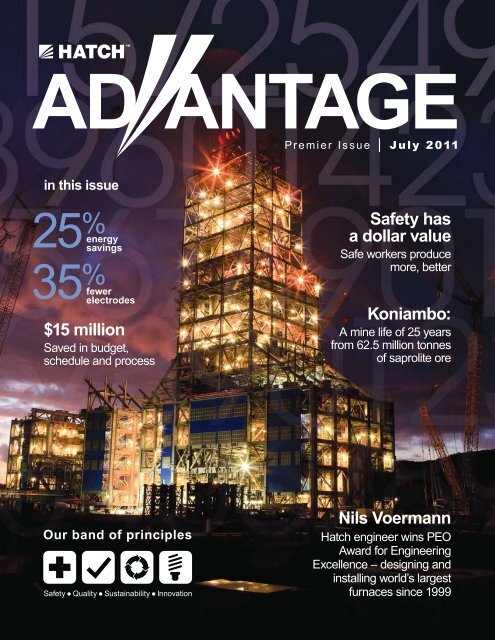
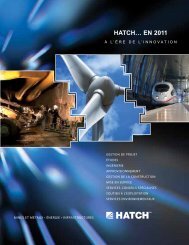
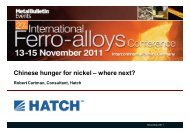
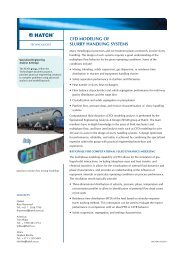




![Presentation: Global Overview of Line Pipe [pdf, 618 KB] - Hatch](https://img.yumpu.com/22183381/1/190x132/presentation-global-overview-of-line-pipe-pdf-618-kb-hatch.jpg?quality=85)
![Sustainable Development Report 2010 [pdf, 2.13 MB] - Hatch](https://img.yumpu.com/22183361/1/190x245/sustainable-development-report-2010-pdf-213-mb-hatch.jpg?quality=85)
![This is Hatch 2011 - Our Organization [pdf, 636 KB]](https://img.yumpu.com/22183357/1/190x245/this-is-hatch-2011-our-organization-pdf-636-kb.jpg?quality=85)
![Annual Review - This is Hatch 2006 [pdf, 1.88 MB]](https://img.yumpu.com/22183355/1/190x245/annual-review-this-is-hatch-2006-pdf-188-mb.jpg?quality=85)
![Hatch Safety Report 2007 [pdf, 2.89 MB]](https://img.yumpu.com/22183353/1/190x245/hatch-safety-report-2007-pdf-289-mb.jpg?quality=85)
![Structural Assets Newsletter #16, October 2002 [pdf, 322 KB] - Hatch](https://img.yumpu.com/22183350/1/184x260/structural-assets-newsletter-16-october-2002-pdf-322-kb-hatch.jpg?quality=85)
